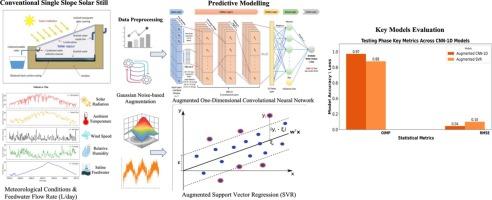Advancing predictive modeling in conventional solar stills: a deep learning approach leveraging data augmentation and convolutional neural networks
IF 10.9
1区 工程技术
Q1 ENERGY & FUELS
引用次数: 0
Abstract
Accurate forecasting of freshwater productivity from conventional single-slope solar stills is crucial for enhancing operational efficiency and minimizing capital costs. A persistent challenge in this domain is the scarcity of experimental data, which limits the training of reliable predictive models. This study proposes a data-efficient forecasting framework that integrates a one-dimensional convolutional neural network (CNN-1D) with time-series data augmentation. Gaussian noise sampled from (0, 0.012) was applied exclusively to the training set, generating six augmented samples per instance. Both the augmentation factor (six) and the look-back window (seven days) were selected through systematic optimization, ensuring preservation of temporal dependencies. The CNN-1D architecture comprised three convolutional layers with 128 filters, ReLU activations, a flattening stage, and a dense regression output layer. Hyperparameters—including learning rate, batch size, kernel size, and regularization strength—were fine-tuned using Tree-structured Parzen Estimator (TPE) optimization with a maximum of 50 trials, where the best-performing configuration achieved the lowest loss. Model training employed a feed-forward backpropagation algorithm with 365 daily observations to predict freshwater yield (Pstd, L/day). Benchmarking against an optimized support vector regression (SVR) model with a radial basis function kernel revealed that the augmented CNN-1D achieved superior performance (RMSE = 0.04, MAE = 0.03, OIMP = 0.97), consistently outperforming both the baseline CNN-1D and the optimized SVR. Residual analyses confirmed its robustness, minimal bias, and strong generalization across unseen data. These findings demonstrate that combining augmentation with hierarchical feature extraction enables a scalable and computationally efficient predictive tool for solar still performance, offering significant potential for sustainable freshwater management in arid and data-constrained regions.

推进传统太阳能蒸馏器的预测建模:利用数据增强和卷积神经网络的深度学习方法
准确预测传统单坡太阳能蒸馏器的淡水生产力对于提高运营效率和最大限度地降低资本成本至关重要。该领域的一个持续挑战是实验数据的稀缺性,这限制了可靠预测模型的训练。本研究提出了一个数据高效的预测框架,该框架将一维卷积神经网络(CNN-1D)与时间序列数据增强相结合。从N(0,0.012)采样的高斯噪声专门应用于训练集,每个实例生成6个增广样本。增强因子(6)和回望窗口(7天)都是通过系统优化选择的,确保了时间依赖性的保留。CNN-1D架构包括三个卷积层,其中包含128个滤波器,ReLU激活,平坦阶段和密集回归输出层。使用树结构Parzen Estimator (TPE)优化对超参数(包括学习率、批处理大小、内核大小和正则化强度)进行了微调,最多进行了50次试验,其中性能最好的配置实现了最低的损失。模型训练采用一种前馈反向传播算法,每天365次观测来预测淡水产量(psd, L/day)。基于径向基函数核的优化支持向量回归(SVR)模型的基准测试表明,增强后的CNN-1D取得了优异的性能(RMSE = 0.04, MAE = 0.03, OIMP = 0.97),始终优于基线CNN-1D和优化后的SVR。残差分析证实了它的稳健性,最小的偏差,以及对未知数据的强泛化。这些发现表明,将增强与分层特征提取相结合,可以为太阳能蒸馏器性能提供可扩展且计算效率高的预测工具,为干旱和数据受限地区的可持续淡水管理提供了巨大潜力。
本文章由计算机程序翻译,如有差异,请以英文原文为准。
求助全文
约1分钟内获得全文
求助全文
来源期刊

Energy Conversion and Management
工程技术-力学
CiteScore
19.00
自引率
11.50%
发文量
1304
审稿时长
17 days
期刊介绍:
The journal Energy Conversion and Management provides a forum for publishing original contributions and comprehensive technical review articles of interdisciplinary and original research on all important energy topics.
The topics considered include energy generation, utilization, conversion, storage, transmission, conservation, management and sustainability. These topics typically involve various types of energy such as mechanical, thermal, nuclear, chemical, electromagnetic, magnetic and electric. These energy types cover all known energy resources, including renewable resources (e.g., solar, bio, hydro, wind, geothermal and ocean energy), fossil fuels and nuclear resources.
 求助内容:
求助内容: 应助结果提醒方式:
应助结果提醒方式:


